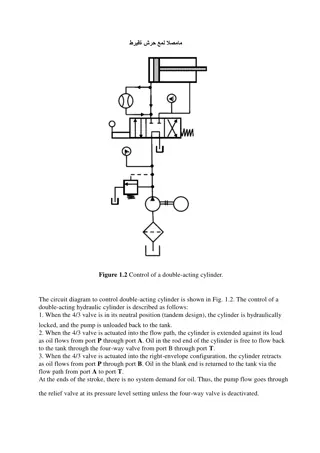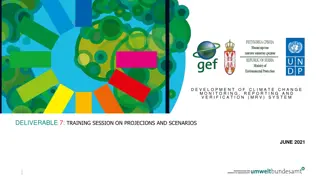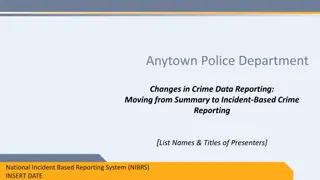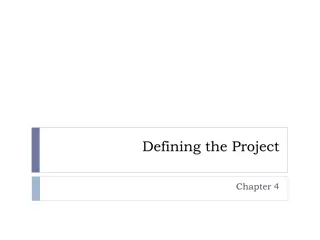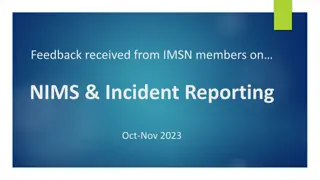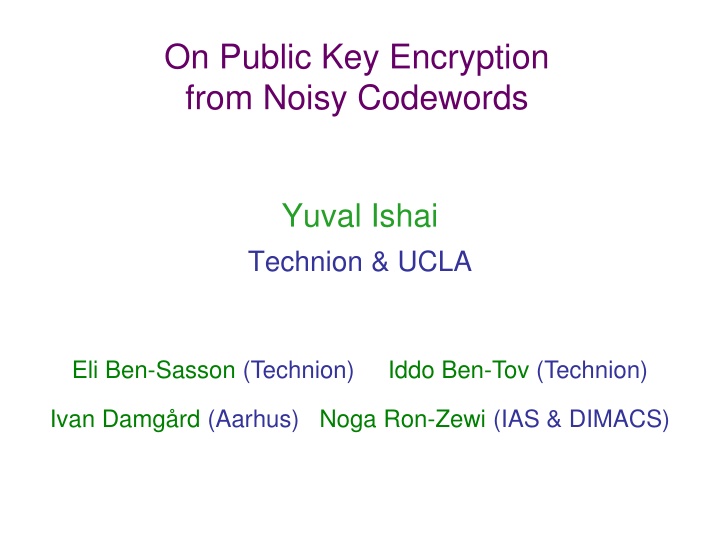
Hydraulic Engineering Project Scope & Reporting
Explore the design project scope in hydraulic engineering focusing on the study area description, operations, potential alterations, and impact evaluation. Learn how to structure reports, anticipate outputs, and assess projects based on creativity, competence, and presentation quality.
Download Presentation

Please find below an Image/Link to download the presentation.
The content on the website is provided AS IS for your information and personal use only. It may not be sold, licensed, or shared on other websites without obtaining consent from the author. If you encounter any issues during the download, it is possible that the publisher has removed the file from their server.
You are allowed to download the files provided on this website for personal or commercial use, subject to the condition that they are used lawfully. All files are the property of their respective owners.
The content on the website is provided AS IS for your information and personal use only. It may not be sold, licensed, or shared on other websites without obtaining consent from the author.
E N D
Presentation Transcript
On Public Key Encryption from Noisy Codewords Yuval Ishai Technion & UCLA Eli Ben-Sasson (Technion) Iddo Ben-Tov (Technion) Ivan Damg rd (Aarhus) Noga Ron-Zewi (IAS & DIMACS)
The Big Picture Theory of cryptography has many open questions Feasibility: Do secure multilinear maps exist? Efficiency: 2t-secure PKE with O(t)-bit ciphertexts? Typical methodology: Prove result X under acceptable assumption Y Notion of acceptable is somewhat arbitrary What if this methodology fails? Alternative methodology (this talk): Identify a class C of natural constructions Identify a class A of natural attacks Study existence and efficiency of constructions from C resisting A A combinatorial problem, no inherent barriers Systematic way for navigating crypto dark matter May lead to new acceptable assumptions
The Big Picture Natural attacks Provable consequences of acceptable assumptions
The Big Picture Natural attacks Heuristic constructions resisting natural attacks
Public Key Encryption Private key encryption: Easy to achieve heuristically, many solid candidates Public key encryption: Relatively few candidates Non-trivial attacks (e.g., sub-exponential attacks, quantum attacks) Less efficient in practice (e.g., RSA vs. AES)
Are current PKE candidates asymptotically optimal? Consider goal of encrypting 1-bit message with security against circuits of size 2t Allow small probability of decryption error Optimization questions: Minimize public key and ciphertext length Minimize decryption time (circuit size) Ideally: O(t) Current candidates fall short of ideal Factoring Discrete logarithm Error-correcting codes (McEliece/Niederreiter-style) Error-correcting codes / lattices (Alekhnovich/Regev-style)
PKE from Noisy Codewords Three well-known PKE schemes: Alekhnovich (Alek) [FOCS 2003] Regev [STOC 2005] Gentry-Peikert-Vaikuntanathan (GPV) [STOC 2008] Common syntactic features: Public random linear code C: n-dim subspace of Fqm Public key and ciphertext of the form w+e w is a secret random codeword in C (or a related public C ) e is a secret noise vector (Alternatively: syndrome H(w+e)=He) Decryption via inner product in Fqm Security relies on pseudorandomness of w+e Follows from low-noise LPN (Alek) or LWE (Regev,GPV)
PKE from Noisy Codewords Alek Regev, GPV Noise = small discrete Gaussian 1 m q= field size = poly(m) Noise = Binary field (q=2) Bin m, Binary field: concrete efficiency [Hopper-Blum01, Damg rd-Park12, Pietrzak12, ] Large field size O m'/logm' ( ) ( ) Lattice-based -attack: 2 Security against -attacks => public keys / ciphertexts of size W(tlogt) O m Brute-force -attack: 2 Security against -attacks => public keys / ciphertexts of size W(t2) 2t 2t m'= mlogq = max(|pk|,|ct|)
PKE from Noisy Codewords Regev, GPV Alek Binary field Large field ( ) O m'/logm' ( ) -attack 2 O m -attack 2 Main question: Noise distributions over binary field with better security guarantees? Dream goal Second-best Binary field -secure 2 Binary field -secure 2 W m ( ) W m/logm ( )
Our Results Unified framework for PKE from noisy codewords Captures Alek, Regev, GPV, extends [Micciancio10] Allows arbitrary choice of field size and noise distributions Unconditionally ruling out dream goal 2O(m/logm) attack for any distribution over the binary field Based on agnostic learning of parities [Blum-Kalai-Wasserman03, Kalai-Verbin-Mansour08] Implies LPN algorithm with n1+ samples in time 2O(n/loglogn) [Lyubashevsky05, Kopparty-Saraf10]
Our Results Main result: Connecting second best to additive combinatorics -time attack for any distribution over the binary field, assuming approximate duality conjecture Flip side: counter-examples to conjecture likely to yield PKE candidates with useful features ( ) O m 2 Study possibility of perfect decryption over constant- size rings Negative result over F2 Candidate construction (?) over constant-size rings using matching vector families
The Unified Framework msk,m0,m1 msk,m1 Parameters: Field , noise distributions over such that msk,m0 efficiently distinguishable E.g., sk=( ,1) b=( ,b), | |,| | < m1/2 Encryption (of bit b) Key Generation sk= e~ msk [Noise] e ~ mb GT pkT ( ) C = Ker => e^ C [Code] pk = w+e, w RC [Noisy codeword] Enc(b)= w+e, w RC ( )= sk,Enc(b) = e,w + e,e = e,e =0 Decryption Dec Enc(b)
Unified Framework P Claim: For each {Alek,Regev,GPV} there exists a choice of parameters such that the unified scheme is equivalent to in terms of security. P Noisy Codeword Alek q=2, w + e 1 m noise distribution = Bin m, noise vector random codeword in C Regev, GPV q=poly(m), noise distribution = small discrete Gaussian Syndrome H (w+e) = H e Parity-check matrix for C
How to Pick Noise? Focus on q=2 Simplified question: find , ~ F2msuch that: < , > is strongly biased towards 0 LPN is hard with respect to both and Natural approaches , of weight < m1/2 low entropy brute force attack , in dual linear spaces V,V linear algebra attack Combinations of above combinations of attacks Can we add entropy while avoiding linear structure? Related to hard questions in additive combinatorics Polynomial Freiman-Ruzsa (PFR) conjecture: |A+A| k|A| k-c-dense subset A with |span(A )| kc|A|
Approximate Duality -Pra A,b B Duality measure: D(A,B)= Pra A,b B a,b =0 a,b =1 D(A,B)=1 D(A,B) 0 A' A,B' B D(A',B')=1 D(A,B) 0
Approximate Duality -Pra A,b B Duality measure: D(A,B)= Pra A,b B a,b =0 a,b =1 D(A,B)=1 D(A,B) 0 A' A,B' B D(A',B')=1 D(A,B) 0 Thm. [BenSasson-RonZewi11] D(A,B) 0.99 D(A',B')=1 for | A'| | A|,| B'| | B| 2-m/100
Approximate Duality Conjecture Thm. [BenSasson-Lovett-RonZewi12] Assuming PFR conjecture, D(A,B) 0.99 D(A',B')=1 for | A'| | A|,| B'| | B| 2-O(m/logm) Approximate duality conjecture: D(A,B) 0.99 D(A',B')=1 for | A'| ( ) | A|,| B'| -O m | B| 2 Tight for A=B=all vectors of hamming weight . Implied by stronger PFR-type conjectures Provable variant over reals [Lovett14] c m Applications in complexity theory: Construction of two-source extractors [BenSasson-RonZewi11] Relating rank to communication complexity [BLR12] Lower bounds on matching vector codes [Bhowmick-Dvir-Lovett13]
( ) -attack over Binary Field O m 2 Either or have a dense core which is covered by few low-dimensional affine spaces Attack either pk or ct via brute force + linear algebra Technicalities Reduce weighted version of approximate duality conjecture to unweighed version Deal with false positives
Open Questions W m/logm ( ) -secure noise distributions over binary field? 2 Approximate duality conjecture False True Applications in complexity theory Strong candidate PKE
Open Questions Non-binary fields Conjecture makes sense for constant-size fields For what field size does attack break down? How about constant-size rings? Uniform attacks? Our attacks are inherently nonuniform Uniform version of approximate duality? Eliminating decryption error Impossible over F2. How about F5? Z6?





